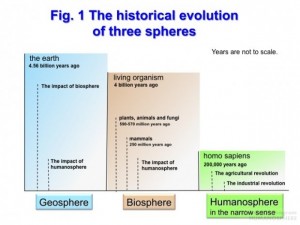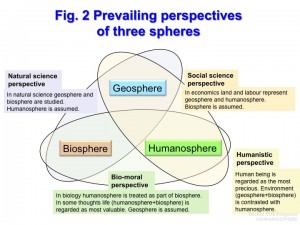What is the Sustainable Humanosphere?
The three domains that support human existence: the humanosphere, biosphere, and geosphere
What is the sustainable Humanosphere? In this context, we use the term “existence” to mean “survival.” Although everything that is alive can be said to exist, what we are concerned with is our survival as humans–as individuals, as a group, and as a species—in other words, the survival of the human race.
As the domain in which the struggle for human existence occurs, the humanosphere, while supported by biosphere and geosphere around it, also greatly impacts these two spheres. The geosphere, biosphere, and humanosphere encompass different historical timespans. In comparison to the geosphere , which began with the formation of the earth some 4.6 billion years ago, the humanosphere in which modern humans appeared only began to take shape two hundred thousand years ago. The various phenomena that occur within each of these domains or that stem from interaction among these domains vary widely from region to region. In attempting to comprehend the “sphere of existence” that comprises the three domains supporting human existence, our goals are (i) to understand how humans have constructed the Humanosphere within the historical context of this “sphere of existence,” (ii) to survey how the Humanosphere is received and passed on or re-constructed by local societies in the present era, and (iii) to comprehensively examine the relationships among and sustainability of these domains from a long-term and broad perspective encompassing all three domains.
The Humanosphere in the Historical Context
Let us first trace the history of the Humanosphere. The initial activities of early hunter-gatherer societies were geared primarily towards the preservation (i.e. survival) of individuals in local contexts through the procurement and maintenance of food supply and avoidance of disease. With the subsequent adoption of agriculture, the focus of activities shifted to expansion of technology and institutions and reproductive activities involving a continuous cycle of consumption and production, giving a social character to survival at the regional level. This led to the emergence of the concept of respecting individual personalities and relative differences within and among societies and, based thereupon, the introduction of arrangements to acknowledge and care for others, i.e. endowing human society with “humanitarian” values. Despite the gradual increase in human population during this period, the natural world was fundamentally governed by the logic of the geosphere and the logic of the biosphere. With arrival of industrial society, the humanosphere experienced a dramatic expansion of production and global spread of industrialization. Particularly impactful was the massive use of fossil fuels following the industrial revolution. The result was a sudden and explosive increase in consumption. We have now entered an age of globalization marked by the free movement of goods, capital, and labor, increasing lifespans, and ascendancy of the humanosphere. As a result, the goal of “subsistence” for modern humans is the procurement of goods, services, transportation, and access to infrastructure that are the necessary means for modern living. Meanwhile, this change has led to increased risk of human-caused environmental destruction, problems related to the depletion of natural and energy resources, and the widespread adoption of a monolithic value system that, by its nature, relegates the value of care to the hinterlands of society.
The Humanosphere and its Sustainability
It is self-evident that the Humanosphere is sustained by the “sphere of existence” comprising the three domains. Our existence is only possible through our relations with others, our place within the web of life, and our coexistence with the environment. Existence, by its very nature, is uncertain. The existence of every human as individual organisms must come to end. The groups to which such individuals belong evolve, develop, and disappear within the context of history of society and the environment. The Humanosphere, then, can perhaps be considered the means by which we attempt to ensure our existence which, by its nature, is uncertain.
When discussing the environmental foundation necessary for a sustainable humanosphere, we must not forget that what is essential for ensuring the continued existence of the Humanosphere is ability of humans to cope with issues and phenomena that are beyond the bounds of modern science and technology, that are the result of uncertainty arising from the interaction or overlaying of disparate logics of the humano-, geo-, and biospheres, and that are simply beyond the reach of our knowledge. The logic of the humanosphere differs greatly from region to region. The central principle in the logic of biosphere is diversity. It is critical that we understand this regionality and diversity is critical. It is through investigation of these two principles and pursuit of pathways to harmony within regional contexts that we will find the keys to creating a sustainable Humanosphere. If we define sustainable environment as the condition in which development of human society occurs in a manner congruent with the logics of the geosphere and the biosphere, we must strive to create a system for sustainable interaction that is closely linked with the logic of existence and a Humanosphere that is materially and psychologically fulfilling.
Let us again return to the definition of sustainable Humanosphere. By widening our search for the conditions necessary for achieving a sustainable Humanosphere as broadly as possible, by establishing the sphere of existence as the primary unit for analyzing the sustainability of an environment, and by defining the Humanosphere as the material and psychological conditions necessary for individuals to survive or for local communities to maintain themselves, our ultimate goal is to elucidate tangible and practical pathways for creating a sustainable Humanosphere at local, regional, and global scales.
All of the above content was drawn from G-COE Newsletter No. 7, paraphrasing the introductory chapter of Section 2-2-20 “The Geosphere, Biosphere, and Humanosphere,” in Vol. 6 of Lecture on the Theory of the Humanosphere.



